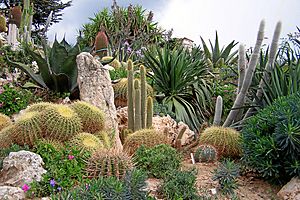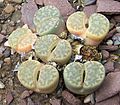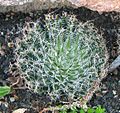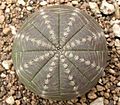Succulent plant facts for kids
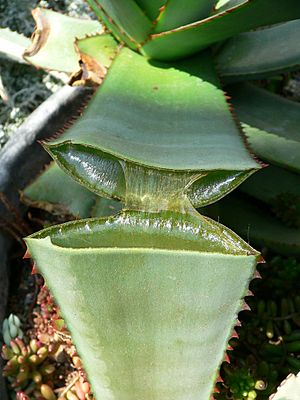
Succulent plants are amazing plants that have learned to live in very dry places. They can store water in their leaves, stems, or roots. This special ability often makes them look different from other plants, usually with thicker, fleshy leaves. A great example of succulents are cacti. Almost all cacti are succulents, but not all succulents are cacti! Other plant families that include succulents are the agavaceae (like the Agave plant), Azioaceae, and Crassulaceae. You might also know plants like the Aloe and the Bottle tree, which are also succulents.
Contents
What Do Succulent Plants Look Like?
Because succulent plants store water, they often look swollen or fleshy. This special look is called "succulence." Besides storing water, these plants have other cool ways to save water. Here are some of their clever features:
- Special Breathing: They use a process called Crassulacean acid metabolism (CAM). This helps them open their tiny pores (called stomata) at night to take in air, which means they lose less water during the hot day.
- Leaf Shapes: Their leaves might be missing, very small, or shaped like cylinders or balls. This reduces the surface area exposed to the sun, so less water evaporates.
- Fewer Pores: They have fewer stomata (the tiny holes plants use to breathe) to cut down on water loss.
- Stem Power: For some succulents, their stems do most of the photosynthesis (making food from sunlight) instead of their leaves.
- Compact Shapes: They often grow in tight, cushion-like, tall, or round shapes. These forms help them stay cool and keep water inside.
- Ribs and Folds: Many have ribs or folds that let them quickly expand to hold more water when it rains. These also help reduce the surface area that gets hit by the sun.
- Protective Coating: Their outer surfaces can be waxy, hairy, or spiny. This creates a small, humid area around the plant, slowing down air movement and providing shade, which means less water loss.
- Shallow Roots: Their roots often grow very close to the soil surface. This allows them to quickly soak up water from small rain showers or even heavy dew.
- Heat Resistant: They can stay full of water even when their inside temperature gets very high (like 52°C or 126°F!).
- Tough Skin: They have a very strong outer skin (cuticle) that doesn't let much water escape.
- Water-Holding Gel: Some succulents have gooey substances called mucilage inside them, which are great at holding onto water.
Where Do Succulent Plants Live?
You can find succulents on every continent except Antarctica! While many people think succulents only live in super dry places like steppes, semi-deserts, and deserts, the driest parts of the world aren't actually the best homes for them. For example, Australia, which is the driest continent, has very few native succulents because of long, frequent droughts. Even Africa, which has the most native succulents, doesn't have many in its most arid regions.
However, even though succulents can't grow in the absolute harshest conditions, they can thrive in places where other plants can't survive. Many succulents do very well in dry conditions, and some can even last up to two years without water, depending on their surroundings and how well they've adapted!
Sometimes, succulents grow as epiphytes. This means they grow on other plants, like trees, without touching the ground. They rely on their ability to store water and get nutrients in other ways. An example of this is Tillandsia. Succulents also live along sea coasts and around dry lakes. These places have high levels of dissolved minerals that would kill most other plants, but succulents can handle it! You can also easily grow potted succulents indoors with just a little bit of care.
Images for kids
-
The Lithops looks like a stone, but is in fact a plant. It also stores water in its leaves.
-
The bottle tree stores water in its trunk, that looks like a bottle
-
Prickly pear is a kind of cactus
-
Cactaceae: Rebutia muscula, a stem succulent
-
Crassulaceae: Crassula ovata, a stem and leaf succulent
-
Euphorbiaceae: Euphorbia obesa ssp. symmetrica, a stem succulent
-
Cylindropuntia imbricata: a stem, woody succulent
-
Malvaceae: Adansonia digitata, a stem succulent
-
Asparagaceae: Beaucarnea recurvata, a stem succulent
-
Asparagaceae: Dracaena draco, a stem succulent
See also
 In Spanish: Suculenta para niños
In Spanish: Suculenta para niños


